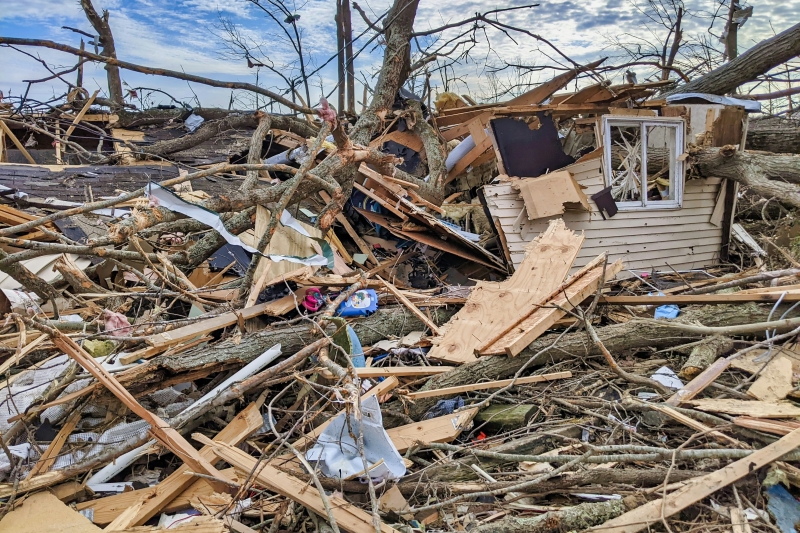
At Paul Davis Restoration of Boise, we’re more than just a team that steps in after the disaster has struck. We’re your partners in preparing for and mitigating the impact of natural calamities, including earthquakes. Earthquakes can strike without warning, causing significant damage to structures and posing serious risks to personal safety.
This article is crafted to guide you through essential earthquake safety procedures, aiming not just to inform but to empower you and your loved ones with knowledge and strategies for safety and resilience.
Understanding Earthquake Risks
Earthquakes are a natural phenomenon caused by the movement of tectonic plates beneath the earth’s surface. These movements can result in shaking that can damage buildings, roads, and other infrastructure. Depending on the magnitude, earthquakes can cause extensive damage to both property and lives. Knowing the risks and preparing accordingly can significantly reduce the impact of these natural events.
Before an Earthquake: Preparation is Key
Create an Emergency Plan: Discuss with your family or housemates what to do during and after an earthquake. Identify safe spots in every room, such as under sturdy furniture or against an interior wall, away from windows that could shatter.
Emergency Supplies Kit: Assemble an emergency kit that includes water, non-perishable food, a flashlight, batteries, a first-aid kit, medications, and important documents. Make sure everyone knows where this kit is kept.
Secure Your Home: Bolt and brace water heaters and gas appliances to wall studs. Anchor heavy furniture, cupboards, and appliances to the walls or floor. Evaluate your home’s structural integrity and consider professional retrofitting if necessary.
During an Earthquake: Drop, Cover, and Hold On
Drop to the Ground: At the first sign of shaking, drop down on your hands and knees. This position prevents you from being knocked down and allows you to move if necessary.
Take Cover: Seek shelter under a piece of sturdy furniture or against an interior wall, protecting your head and neck with your arms.
Hold On: If you’re under shelter, hold on to it with one hand and be ready to move with it until the shaking stops. If you’re not near a shelter, continue to protect your head and neck with your arms.
After an Earthquake: Assess and Act
Check for Injuries: Ensure you and others are safe before moving. Provide first aid where necessary and seek medical attention for serious injuries.
Inspect Your Home: When it’s safe, inspect your home for damage. Be cautious of potential hazards like gas leaks, electrical short circuits, and structural damage.
Stay Informed: Use a battery-operated or hand-crank radio to listen to emergency broadcasts. Follow the instructions of local authorities.
Reach Out for Help: If your home has sustained damage, reaching out to professional restoration services like Paul Davis Restoration of Boise can expedite your return to normalcy. Our team is equipped to handle earthquake damage restoration, ensuring your property is safely and efficiently restored.
Building a Safer Tomorrow
Understanding and implementing earthquake safety procedures can significantly mitigate the risks associated with earthquakes. At Paul Davis Restoration of Boise, we’re committed to helping our community prepare for and recover from natural disasters. Our services, including earthquake damage restoration, are designed to provide peace of mind and swift recovery following seismic events.
Your Safety, Our Priority
In conclusion, while earthquakes are unpredictable, being prepared can make all the difference. By following these safety procedures before, during, and after an earthquake, you can protect yourself, your loved ones, and your property. Remember, in the aftermath of an earthquake, Paul Davis Restoration of Boise is here to help restore your home and your life.
Ready to Learn More? If you’re looking to enhance your earthquake preparedness or need assistance after a quake, don’t hesitate to reach out to us. Our expert team is ready to provide support and guidance every step of the way.
Related Questions
How can I make my home more earthquake-resistant?
Securing heavy furniture and appliances, retrofitting your property to improve structural integrity, and ensuring your home complies with local building codes are effective strategies to make your home more earthquake-resistant.
What should be included in an emergency supplies kit?
Your kit should include water, non-perishable food, a flashlight, batteries, a first-aid kit, medications, important documents, and any special needs items for infants, elderly family members, or pets.
How do I know if my property needs professional earthquake damage restoration?
If you notice structural damage, water leaks, gas leaks, or any other serious damage following an earthquake, it’s crucial to consult with professionals like Paul Davis Restoration for a thorough assessment and restoration plan.
Can earthquakes be predicted?
Currently, scientists cannot predict earthquakes with specific accuracy regarding the date, time, and location. However, research and monitoring of seismic activity can offer general insights into the likelihood of earthquakes in certain areas.
